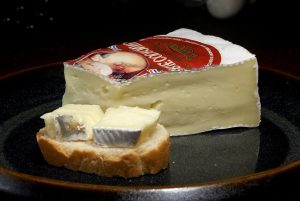Q. I’m a college student with limited options when it comes to cooking but I also happen to love cheese. My real question is “Can you microwave Brie?”

Can you microwave brie?
A. While you may have some reservations about microwaving a cheese like Brie, the good news is that it is perfectly fine to pop your Brie into the microwave for a bit. The end result will be an ooey-gooey mass of deliciousness that will be just perfect for whatever you might want to improved with the taste of cheese.
Q. Can you microwave Brie while leaving the rind on top of the cheese?
A. While you can leave the rind on your Brie as your microwave it, any melting that occurs in your Brie is going to be incidental at best. With the rind remaining on the cheese, a good amount of the microwaves are going to focus onto the rind, rather than the cheese itself. If you want a properly melty cheese, that rind needs to come off. That said, you should not throw the rind away as it is not made of wax but is actually an edible form of white mold that not only helps to protect Brie but is also responsible for a good bit of this specific cheese’s distinct flavor.
Q. More than one of my friends has said that Brie is one of the best cheeses around. Well I tried some of the stuff right out of the fridge and I don’t get why they were so over the moon with the stuff. Maybe the trick is heat?
A. Most people would agree with you that cold Brie is not the most appetizing things in the world. Sure, its still cheese but the texture of Brie is best experienced after it has spent a little bit of time in the microwave, just enough to properly soften it up for consumption aside a variety of finger foods.
How to Microwave Brie
The very first step when it comes to microwaving Brie is to remove any wax rind it came with. This will ensure that all of the microwave’s power will reach the cheese and give it an even consistency over the handful of minutes it takes to reach a proper texture. One other benefit of getting rid of the rind is that you now have a bare Brie wheel that should make it much easier to use for dipping vegetables, sausages, crackers and so on.
Your next step in properly nuking your Brie is to place a sheet of parchment paper on top of the microwave-safe plate you plan to use to reheat your Brie. The non-stick nature of the paper will make it easier for you to transfer it to the serving platter for whatever party or charcuterie board you have planned.
The next step when it comes to optimally microwaving your Brie is to score the top with a knife. This involves making deep cuts into the top of the cheese. While the most common approach to this method involves crosshatching into a grid, you can really make any sort of design you like. The overall goal of scoring the cheese is to prevent air from escaping and contributing to a cheesy blowout. Note that scoring of Brie should be attempted after you have removed the rind. While it is true that natural rinds on cheeses are perfectly edible, the rind on pieces of Brie is a form of mold and the increased temperatures of a microwave interact in odd ways with mold.
Note that different knifes will offer you different levels of success when you are scoring the Brie. The ideal knife for this specific job is known as an “open work blade knife,” also known as a soft cheese knife. This sort of knife has a blade with holes through it, which might reminding you of Swiss cheese; the holes in this type of knife are designed to reduce the ability to cling to the blade that some soft cheeses are known to posses, making it very easy to push the sliced cheese off of the blade and onto plates.
The final step in microwaving your Brie is to actually place it into the microwave, set the power level, the time and then turn it on. While you should have the microwave set to high power for this task, the time spent heating it up within the microwave plays a major role in the Brie’s final consistency.
- If you run the microwave for just 60 seconds, you will wind up with Brie that will be too solid for spreading onto crackers.
- If you run the microwave for three minutes, you will have melted it considerably beyond the point of being able to have an aesthetically pleasing presentation. While few people will complain about having melted cheese to eat, that goal can be just as easily satisfied with other soft cheeses.
- The ideal time for a wheel of Brie to spend within the interior of a powered up microwave is a mere two minutes. Microwaving your Brie for 120 seconds results in a Brie that is bubbling with molten cheesy goodness yet is also contained enough to offer a crowd-pleasing presentation at a party. If you want to enjoy a cheese with a pleasing degree of pull and only have a microwave as a heat source, two-minute Brie is the way to go.
Now that your Brie has been properly softened, the real question is how you plan to serve it. A cheese board with Brie, nuts, a little jar of honey and fruit offers a pleasing variety of taste options on a very compact platform. While you may wish to use a soft cheese knife for your properly melted cheese, there would be no harm in using a spatula knife, also known as a “cheese spreader,” or a table knife to distribute the melted Brie.